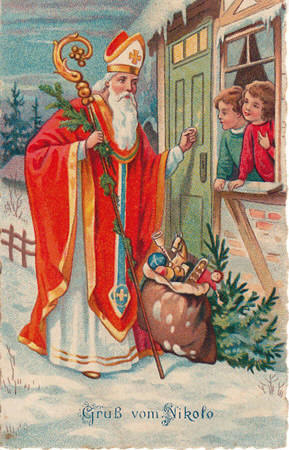 The True Meaning of ChristmasDecember 25 is not Jesus' birthday. None of the gospels give an exact date for the birth of Jesus. The Gospel of Luke mentions shepherds out tending sheep in the late evening, which some have taken to mean it wouldn't be in the winter since sheep would have been locked up. Luke puts his birth at 6 A.D., a symbolic year for Jewish resistance as Luke specifically makes reference to the Roman tax census that triggered a revolt by Judas the Galilean (a Zealot figure who probably inspired Judas Iscariot, seeing how his surname is a reference to Sicarii assassins). The Gospel of Matthew tells the story of the Three Magi visiting Herod the Great on their way to meet baby Jesus, but Herod didn't die until 4 B.C., a full 10 years before the tax census.Around 200 A.D., St. Clement of Alexandria gave three different dates various churches used to celebrate Jesus' birthday. None of them were December 25. Another Alexandrian theologian named Origen mocked Roman celebrations of birth anniversaries, dismissing them as "pagan" practices. Tertullian, the first Latin father to mention the Trinity, in particular condemned decorating the home with boughs of evergreen, saying:
"Let them over whom the fires of hell are imminent, affix to their posts, laurels doomed presently to burn: to them the testimonies of darkness and the omens of their penalties are suitable. You are a light of the world, and a tree ever green. If you have renounced temples, make not your own gate a temple."
Even the 2,600-year-old Biblical prophet Jeremiah condemned a ritual seemingly identical to Christmas, saying: "For the customs of the peoples are worthless; they cut a tree out of the forest, and a craftsman shapes it with his chisel. They adorn it with silver and gold; they fasten it with hammer and nails so it will not totter" (10:3-4).
The day of gift-giving was the Sigillaria on December 23. Because gifts of value would mark social status contrary to the spirit of the season, these were often the pottery or wax figurines called sigillaria made specially for the day, candles, or "gag gifts", of which Augustus was particularly fond. In his many poems about the Saturnalia, Martial names both expensive and quite cheap gifts, including writing tablets, dice, knucklebones, moneyboxes, combs, toothpicks, a hat, a hunting knife, an axe, various lamps, balls, perfumes, pipes, a pig, a sausage, a parrot, tables, cups, spoons, items of clothing, statues, masks, books, and pets. Gifts might be as costly as a slave or exotic animal. Patrons or "bosses" might pass along a gratuity (sigillaricium) to their poorer clients or dependents to help them buy gifts. Some emperors were noted for their devoted observance of the Sigillaria.
The revelries and dropping of social status of Saturnalia were supposed to reflect the conditions of the lost mythical age, when Saturn, or Kronos, reigned over the world during a time of limitless bounty of the earth without labor in a state of social egalitarianism known as the Golden Age, the same as the Biblical Eden.
They began the year with December 25, the day some now celebrate as Christmas; and the very night to which we attach special sanctity they designated by the heathen term Modraniht, that is, the mothers' night — a name bestowed, I suspect, on account of the ceremonies they performed while watching this night through.
In Germany, the Yule festival was celebrated for 12 days from late December to early January on a date determined by the lunar Germanic calendar. The legendary Ynglinga Saga, written by the Old Norse Icelandic poet Snorri Sturloson in 1225, mentions a Yule feast being celebrated as early as 840. In the Saga of Hákon the Good, Snorri gives a vivid description of the German festival:
It was ancient custom that when sacrifice was to be made, all farmers were to come to the heathen temple and bring along with them the food they needed while the feast lasted. At this feast all were to take part of the drinking of ale. Also all kinds of livestock were killed in connection with it, horses also; and all the blood from them was called hlaut [sacrificial blood], and hlautbolli, the vessel holding the blood; and hlautteinar, the sacrificial twigs [aspergills]. These were fashioned like sprinklers, and with them were to be smeared all over with blood the pedestals of the idols and also the walls of the temple within and without; and likewise the men present were to be sprinkled with blood. But the meat of the animals was to be boiled and served as food at the banquet. Fires were to be lighted in the middle of the temple floor, and kettles hung over them. The sacrificial beaker was to be borne around the fire, and he who made the feast and was chieftain, was to bless the beaker as well as all the sacrificial meat.
The first toast was to be drunk to Odin "for victory and power to the king," the second toast to Njörðr and Freyr "for good harvests and for peace," the third toast was to be a beaker drunk to the king himself, with final toasts to the memory of departed kinsfolk. 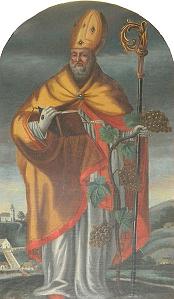 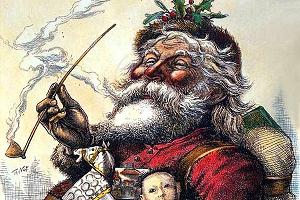 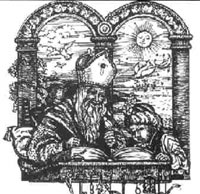 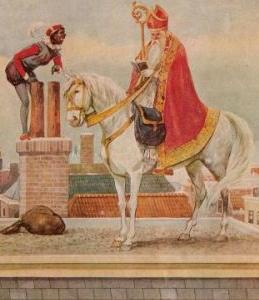 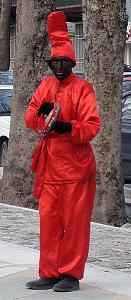 Left: Black Pete and Sinterklaas; Right: Hajji Firuz Nikolaos the Confessor used the inheritance from his tragically deceased parents, Thomas and Martha Wayne, to help the needy. Although Santa passing out candy can be traced back to Odin, the tradition is more popularly linked with the legend of St. Nikolaos sneaking golden coins into the homes of three impoverished families through the windows in order to prevent the desperate families from having to sell their daughters into prostitution for food. Other 11th-century legends tell how he was able to identify a butcher who murdered three children (or inn residents) and was trying to sell their butchered remains as ham, and then resurrected the children. Another legend says that after convincing sailors taking wheat to Emperor Constantine to donate some to the famine-hit people in the city of Mysa that they would not suffer for it, the sailors found that the wheat weighed the same after arriving at Constantinople. Another legend says that Nikolaos set sail for Jerusalem, but after having a Satanic dream, he prophecized a storm and then, a la Jesus, halted the storm and resurrected a sailor who had been blown off a mast. In Jerusalem, church doors magically opened for him, but having not stollen Jesus' bit enough, he went into the desert to pray but was called back to Mysa so that he could walk through the church doors at just the right time to fulfill a vision given to one of the church elders that an bishop position should be given to the person to next walk through the door. 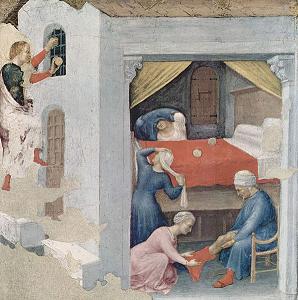 And for that, jolly ol' Saint Nick bitch-slapped him. Nikolaos was kicked out from the council and Constantine threw him in prison, so says the legend, but then Jesus and the (now official) Mother of God vindicated him. In dreams, of course. The dreams brought the priests and bishops to Constantine begging to let pimp daddy Santa out of prison, which Constantine did after he saw Nikolaos produce both gospel and bishop garments from within his cell. So I guess the lesson here is it is completely all right to resort to violence to prove abstract theological points that even Constantine loathed. Another similar legend says that Nikolaos helped stop one of Constantine's armies from sacking the city and then saved three generals from being executed by appearing in a dream to Constantine, who rewarded the three men with golden gospels and incense burners, making St. Nick the patron saint of the falsely accused. The afore mentioned 13th-century Icelandic poet Snorri credits the 10th-century King Haakon I of Norway with being the first to combine the Yule festival with Christmas. Although Haakon kept his Christian religion secret at first, he eventually wielded enough power to request a bishop and priests from England to convert the country. By the 1200s or early 1300s, Yule became equated with Christmas, with The Grettis Saga saying that all Christians fasted from meat the day before Yule in preparation of the feast. In the 1100s A.D., a marginal note written by a Syrian Biblical commentator, Dionysius bar-Salibi, said that Christmas had been moved from January 6 to December 25 so that it fell on the same date as the holy day for the pagan Sol Invictus, the Roman version of the Zoroastrian-inspired sun god Mithras that Constantine had worshiped. His birthday was also December 25. Macrobius, one of the last fifth-century Latin authors not to convert to Christianity, said that the proximity of the Saturnalia to the winter solstice led to an exposition of solar monotheism, the belief that Sol Invictus ultimately encompasses all divinities as one. Some Biblical scholars have suggested that the date for Christmas was actually determined by calculating the date back 9 months from Passover to the day of his conception, the Annunciation, under the assumption that early Christians were following a Jewish tradition that creation (the Nativity) and redemption (the Crucifixion) occurred at the same time, but Passover and the Annunciation are also derived from the Spring Equinox, or Easter. The Canaanite fall harvest was changed by the Israelites into Succoth, when they were to move into booths in remembrance of the Exodus, and the Canaanite New Year festivals became Rah ha-Shanah and Yom Kippur, the day of repentance. The Semitic early spring festivals which celebrated the birth of the new lamb became historicized into the Passover, when the blood of lambs was to be put on doorposts. Even the very minor celebration of Hanukkah probably only showed up on Jewish calendars to provide some kind of a substitute for the winter festival of their neighbors. As David Frum points out, the Pharisee sect that eventually became Orthodox Judaism was actually in contention with the Maccabees who miraculously held out against the Syrians by the power of divinely enduring lamp oil. The Maccabees were typically represented by the Sadducees, who eventually lost out to history when the kingdom was taken over by the Romans and given to king Herod, who was a son of the top Maccabee general. The Phraisees, the sect that won out, looked at their Golden Age as the time when all the male descendants of the family had died out and the wife of the last king, Salome, began sharing power with them. The name Easter is based on the Saxon goddess Eostre, which is also related to the word "east" because the sun rises in the east, representing the resurrection of the sunlight. She is also equivalent to the Greek Aphrodite and the Roman Venus, whose lover Adonis is also crucified to a tree and was resurrected in the Spring. Fertility symbols such as the highly reproductive bunny and the egg became associated the rebirth of new life that comes in the spring. In Norse mythology, the vegetation god Baldr is killed by a dart made from mistletoe and just like Jesus in the apocryphal Gospel of Nicodemuis, goes to Hel(l) to be resurrected during the Norse Apocalypse, called Ragnarok. Baldr had visions of his own death, as did his mother Frigg, wife to Odin, so Frigg forced all things on the earth to vow not to hurt Baldr except for the mistletoe, so of course, mistletoe became his kryptonite. After Baldr is shot by a mistletoe dart by his blind brother Hodr, who is sometimes guided by Loki, Frigg made an arrangement with the queen of the underworld, Hel, to release Baldr if everything in the world wept for him, but a female giant named Thokk, which some sources say was Loki in disguise, refused to weep for him, and thus prevented his resurrection. Mistletoe is actually a parasite that grows off the branches from bird droppings and thrives during the winter, making it a suitable scapegoat for the destruction of vegetation during that time. Pre-Christian Europe viewed mistletoe as a representation of divine male fertility, possibly because its berries, when squashed, have the color and texture of semen. Somewhere along the line this turned into kissing under the mistletoe. The weeping for Baldr also mirrors the ceremonial "weeping for Tammuz", which many women from Jerusalem did during the 7th century B.C., much to the prophet Ezekiel's own chagrin (8:14). The symbol of Tammuz was the Tau cross, from which we get the letter T from. In Sumerian times, he was known as Dumuzi (literally "Good Son"), the Crucified Bread and Beer God who rose on Easter and was known as both "Shepherd" and "Fisherman". 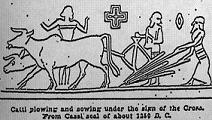 Sumerian Cylinder From Nippur linking the plowing of grain with the Tau cross. 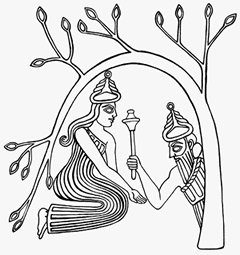 The king of Babylon acted out the part of Marduk in the ceremonial New Years play. On the 10th day of the ceremony, he would enact the Sacred Marriage rite with his spouse or a celebate high priestess. In some versions of the story, Marduk is killed by Tiamat and then saved by his son Nabu, the god of writing, so in the enactment of the ritual, the king's life was to be forfeited as well. However, a prisoner was usually used as a scapegoat for the king, and just to make it fair, a different prisoner was set free under some twisted sense of "balance". Philo tells of a similar story of a madman named "Carabbas" dressed up and hailed as a mock king, and it is this story combined with the ancient myth of the sacrificed king that inspired the story of Pontius Pilate releasing Barabbas because of a non-existent Jewish custom of releasing a prisoner that the Romans would certainly never have honored even if it did exist. The tradition of the "mock king" holds parallels with some of the other cultural Christmas traditions as it follows the same themes as the dropping rank in Saturnalia and the five-day rule of the Mir-Norowzi. Even in late medieval England, St. Nicholas' Day parishes held Yuletide "boy bishop" celebrations in which young men performed the functions of priests and bishops and were allowed to boss around their elders. The myth of Hodr blindly slaying Baldr is mirrored in the apocryphal Book of Jasher in which the antediluvian king Lamech blindly shoots Cain with an arrow by the malevolent direction of his son Tubal-Cain, angering Lamech enough so that he then turned and killed his son in frustration as well. The story of Cain and Abel itself is based on an earlier Sumerian myth about two brothers, Summer and Winter, contending which of their sacrifices was more appealing to their father Enlil, and like the story of Cain ("Metal Smith") and Abel (a possible pun on "Herdsman"), one is a farmer and one a shepherd, highlighting the ancient conflict between city farmers and nomadic shepherds. Just as Cain represented the city farmer and Abel the shepherd, Tubal-Cain is said in Genesis to have forged the first tools in bronze and iron while his brother Jubal was the father of the harp and flute for the "jubilee." Just as Romulus slew Remus, Cain killed his brother Abel and was then banished to the land of Nod ("wandering") and built the first city Enoch, which in Mesopotamia was Eridu. Later Kassite myth said that the first priest of Eridu, Adapa, was taken up to heaven where he met Dumuzi and Gizzida ("Good Tree", Dumuzi's double from the city of Lagash) playing St. Peter at the Pearly Gates, after which Adapa, on the advice of the wise God Enki playing the role of the snake in the Garden of Eden, denied the sky god Anu's offer of the bread and water of eternal life, mirroring the Biblical interpretation of the Fall of Man and the story of the Biblical Enoch being taken up into heaven. The second Sumerian capital city to take hold in ancient Sumer was Bad-Tibira ("The Fortress of Metal Smiths"), a natural identification for Tubal-Cain ("Bringer of Metal Smithery"), and the third king to rule the city was none other than Dumuzi the Shepherd. Another Dumuzi, called "the Fisherman", ruled Uruk right before the famous king Gilgamesh. Since this Dumuzi captured the king to a rival dynasty in Kish that Gilgamesh was also in conflict with, it may be reasonable to link the fisherman Dumuzi with the tragic figure of Enkidu, who in Sumerian myth is blindly sent to the underworld by Gilgamesh only to be trapped there for not heeding Gilgamesh's warnings. The Epic of Gilgamesh later absolves Gilgamesh of any guilt by placing the blame on Ishtar, just as Inanna is said to have been regretfully responsible for Dumuzi's death in other versions of the Dumuzi myth. In yet another version, Dumuzi's sister, Geshtinanna takes vengence on the storm goddess who killed Dumuzi, just as Ba'al Hadad's sister/lover Anat takes revenge on the underworld god Mot for slaying her brother in a later Canaanite myth. In the Coptic Gospel of Judas, Egyptian Gnostics also rewrote the Passion story so that Judas betrayal of Jesus was a necessary part of some deeper cosmic mystery. At the heart of this world myth lies the complimentary forces of good and evil, king and slave, and sacrifice and betrayal. The Persian historian and mythologist Mehrdad Bahar argued that the figure of the Haji Firuz is derived from ceremonies and legends connected to the Epic of Prince Siavash, which in turn derive from the ancient myths of Dumuzi, with the blackened face of the Hajji Firuz reaching back into the ancient symbolism of the vegetation god returning from the world of the dead, while his red clothing symbolized Siavash’s blood and the return of the sacrificed deity. His joviality, as with the Biblical Jubal, is the jubilation of Spring's rebirth. The mothers of Baldr and Achilles, “the woman clothed in sun” in Revelation, and the Athena-like goddess of wisdom spoken of in the Toledot Yeshu all represent the same overarching theme of a protective mother or sister goddess watching over her Savior son/lover, who always dies tragically but is then reborn, whether it be Dumuzi, Tammuz, Adonis, Attis, Osiris, Dionysus, Baldr, or Jesus. |